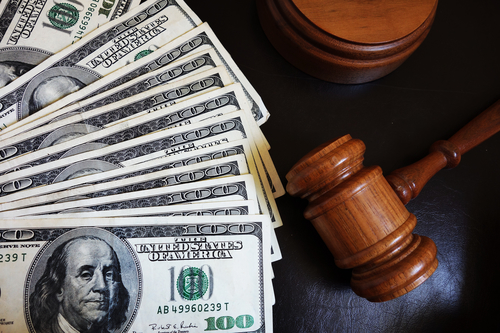Recent Patent Damages Cases May Increase Reasonable Royalties Awards
This article addresses two developments that have begun to take hold in the U.S. District Courts after significant precedential rulings from the U.S. Court of Appeals for the Federal Circuit:
“As these damages issues are continuing to evolve in U.S. District courts and the Federal Circuit,” “Litigants should focus on the facts and the evidence specific to each individual case.”
In recent years, developments in U.S. Patent Damages Law have emerged which may have This article addresses two developments that have begun to take hold in the U.S. district courts after significant precedential rulings from the U.S. Court of Appeals for the Federal Circuit:
Reasonable royalty damages may incorporate the value of foreign economic activity caused by domestic direct infringement under 35 U.S.C. SS 271(a), based upon Brumfield v. IBG LLC 97 F.4th (976 (Fed. Cir. 2024); and
- Reasonable royalty damages for a component supplier may incorporate the value of the invention in markets for downstream products, like finished consumer goods, based on Cal. Inst. Inst. v. Broadcom Ltd., 25 F.4th 976 (Fed. Cir. In some cases, the combination of these concepts can have a multiplicative effect. Combining them can have a multiplicative impact in certain cases. See Georgia-Pacific Corp. U.S. Plywood Corp. 318 F. Supp. 1116, 1120-22 (S.D.N.Y. 1970). In short, the hypothetical negotiation addresses two questions:
- How much more money did the accused infringer make–or could it have made–by using the invention instead of an alternative?
How would the parties have agreed to divide that incremental value in an arms-length negotiation?
After over 50 years of development in the law about the hypothetical negotiation, the Federal Circuit neatly encapsulated the hypothetical negotiation along the lines above in March 2024, in Brumfield: “Many authorities address issues concerning the hypothetical negotiation, which, operating under certain assumptions, at its core is a process for identifying the incremental value of the claimed technology over non-infringing alternatives and determining how that gain would be shared.” 97 F.4th at 876.
- The Brumfield and Caltech decisions address, in different ways, how to answer the first question–determining the incremental value of the invention to the accused infringer–and potentially expand the reach of how to calculate that value by looking to foreign economic activity and downstream product markets. Caltech also raises issues about the second question–how the parties would divide incremental value–and, in particular, what a patent owner may not be willing to give up when granting a hypothetical license to a component supplier.
- Brumfield: Damages Based on Foreign Economic Activity Caused by Domestic Direct Infringement
In Brumfield, the Federal Circuit held that reasonable royalty damages under Section 284 for U.S. direct infringement under Section 271(a) may incorporate the value of foreign economic activity caused by that infringement. If the infringer’s acts of infringement are committed in the United States, such as making or using a patented product, and those acts result in increased value for the infringer abroad, reasonable royalties damages can be allowed to account for that added value. Brumfield, at 878-880. We analyzed these same questions in 2018 when WesternGeco was released and came to the same conclusion that the Federal Circuit reached in Brumfield. A. Fahrenkrog, et al. WesternGeco May Reshape Reasonable royalty damages, Law360, July 13, 2018. WesternGeco addresses Section 271,(f) infringement, and damages for lost profits, but the fundamental principles of the opinion, that Section 271 confines the infringement to domestic activities, and Section 284, merely provides a remedy to this domestic infringement, apply equally to Section 271,(a) direct, and reasonable royalties damages. Brumfield, at 871-76. How those potential damages will be calculated and judged by the courts, however, is far from defined at this point.
Brumfield articulated some initial conceptualizations of standards for proving reasonable royalty damages based on foreign economic activity, but it did not fully establish a legal or evidentiary framework. The Federal Circuit explained that “the hypothetical negotiation must turn on the amount the hypothetical infringer would agree to pay to be permitted to engage in the domestic acts constituting ‘the infringement.'” Further, “the patentee must, at the least, show why that foreign conduct increases the value of the domestic infringement itself–because, e.g., the domestic infringement enables and is needed to enable otherwise-unavailable profits from conduct abroad–while respecting the apportionment limit that excludes values beyond that of practicing the patent.” The Court clarified that “
his kind of causal connection . . . These open issues will no doubt be heavily debated by the district courts. The Federal Circuit made a few additional “observations” in dicta about the causation requirements to provide some guidance. The Court suggested that the Supreme Court’s WesternGeco opinion may require the patentee to establish that domestic infringement proximately caused foreign economic activity. It set forth several formulations of what proximate cause could require in this context (such as “but for causation, plus more,” “the absence of remoteness,” or “reasonable, objective foreseeability”). The Court suggested that the Supreme Court’s WesternGeco opinion may require the patentee to establish that the domestic infringement proximately caused the foreign economic activity, and it set forth several formulations of what proximate cause could require in this context (such as “but for causation, plus more,” “the absence of remoteness,” or “reasonable, objective foreseeability”).
It appears that the hypothetical negotiation framework itself adequately addresses these causation issues–it already requires evidence “for identifying the incremental value of the claimed technology over noninfringing alternatives.”. The hypothetical negotiation framework itself appears to address these causation issues–it already requires evidence “for identifying the incremental value of the claimed technology over noninfringing alternatives.”. The hypothetical negotiation is assessing the value of the claimed inventions on the market. The Federal Circuit’s indication that it may adopt a “proximate-cause” standard suggests that, if confronted with the issue directly, they will likely impose a similar requirement on the patent owner’s theory and evidence. Litigants in the district courts should prepare their cases accordingly.
The Federal Circuit also raised “
nother question” about how, if at all, “the long-recognized general avoidance of extraterritorial reach” could be considered “in applying the proximate-cause requirement . . . WesternGeco, 585 U.S. 407, 414-16. WesternGeco, 585 U.S. 407, 414-16. But this signal should also inform how litigants prepare for their cases in trial courts – their theories and evidence should address that issue. Brumfield, at 878-880. The Court found that both the patent owner and his expert failed to adequately tie their damages theory with a domestic infringing action under Section 271(a). Therefore, they could not clear that threshold issue required by WesternGeco, and the Federal Circuit did not need to address any of its questions about proximate cause or extraterritoriality.
In sum, the Federal Circuit has confirmed that patent owners can pursue reasonable royalty damages based on foreign economic activity caused by direct infringement in the United States. This ruling could change the way damages theories are applied to products and services that have global markets. What can litigants do today to increase their chances of winning on these issues, both under current law and as it changes? The facts and evidence are what will determine the outcome of any patent damages issue. The Federal Circuit has indicated that it will focus on causation–and possibly impose a proximate cause requirement- – and litigants should develop their evidence accordingly. The Federal Circuit has signaled that it will focus on causation–and possibly impose a proximate cause requirement–and litigants should develop their evidence accordingly.[t]Caltech: Damages Based on Downstream Market Value of Infringing Components
In Caltech v. Broadcom (and Apple), the Federal Circuit held that an infringing component (like a Wi-Fi chip) and a finished device (like a smartphone) that also infringed by virtue of including that component should not, “in the absence of a compelling showing otherwise,” bear different royalty rates in a reasonable royalty damages model. Caltech, 25 F.4th 994. The jury awarded Broadcom a royalty per unit of $0.26 for selling Wi-Fi infringing chips and Apple a royalty per unit of $1.40 for selling consumer products like iPhones that infringed due to their Broadcom Wi-Fi chip. Cal. Inst. Broadcom Ltd., Defendant-Appellants’ Brief, 2020 WL 8618020 at *2 (filed in Fed. v. Broadcom Ltd., Defendant-Appellants’ Brief, 2020 WL 8618020, at *2 (filed in Fed. Cir., December 14, 2020) (identifying royalty rates per unit). The Federal Circuit vacated this award, finding that, “the mere fact Broadcom and Apple were separate infringers does not support treating the chips differently at different stages of the supply chain.” Caltech 25 F.4th, at 993-994.1001010At a first glance, it might appear that the Caltech result suggests that the downstream product seller would pay the same lower royalties as the upstream component provider. The Court’s analysis doesn’t go that far. The opinion does not address whether the patent owner must model its damages based on the economics of the component supplier or the finished product seller–the Court did not opine on whether Apple should have paid a lower $0.26 rate, Broadcom should have paid a higher $1.40 rate, or something else entirely. The opinion does not address whether the patent owner must model its damages based on the economics of the component supplier or the finished product seller–the Court did not opine on whether Apple should have paid a lower $0.26 rate, Broadcom should have paid a higher $1.40 rate, or something else entirely.
After Caltech, patent owners should consider developing evidence and argue that a component supplier should pay a royalty rate that accounts for all value that the component contributes through the entire supply chain, through finished product markets. Why? In a hypothetical negotiation, a patent holder would need to consider what rights they would be giving up by signing a licensing agreement. According to U.S. Patent exhaustion laws, these rights would include not only the ability to prevent the component supplier from practising the claimed inventions but also the ability to exclude any downstream seller who incorporates the licensed parts in its products. Quanta Computer, Inc. v. LG Elecs., Inc., 553, U.S. 617, 635-8 (2008); TransCore, LP v. Elec. Transaction Consultants Corp. 563 F.3d. 1271, 1275-1277 (Fed. Cir. 2009). The hypothetical licensee would receive value from both the freedom to practice the inventions itself and also the ability to pass that freedom to its customers.
The patent owner would generally not relinquish that full scope of rights without fair compensation. In a hypothetical negotiation–formulated in Brumfield as “a process for identifying the incremental value of the claimed technology over noninfringing alternatives and determining how that gain would be shared,” 97 F.4th at 876–the parties likely would recognize that the “incremental value” included the market value of the invention in both the component and downstream product markets (including the accused infringer’s customers’ markets), and the patent owner, absent evidence to the contrary, would not “share” the downstream portion of that value for free.[a]As a result, after Caltech litigants, in cases involving component suppliers accused of infringement should consider (and are considering) the value of those components throughout the downstream supply chain when modeling reasonable royalty damages. Accused infringers may want to develop rebuttal evidence illustrating that the accused components do not add additional value in downstream products that would otherwise potentially increase the patent owner’s reasonable royalty damages.
Focus on the Facts
Brumfield, by confirming that WesternGeco allows damages for foreign economic activity, increases the potential reasonable royalty damages available to patent owners. Caltech’s requirement (absent any contrary evidence) that the same royalty rates be applied to different infringing devices within a supply chain may increase the reasonable royalty damages available to component suppliers. Brumfield and Caltech may have a multiplicative effect on damages where the manufacture, development or sales of the components occurs in the United States. As these damages issues continue to evolve in the U.S. district courts and the Federal Circuit, litigants should focus their efforts on the facts and evidence specific to each case–how much more money did the accused infringer make (or could it have made) in foreign and downstream markets by using the invention in the United States instead of an alternative, and how would the parties have agreed to divide that additional value in a hypothetical negotiation?
Image Source: Deposit Photos
Author: zimmytws
Image ID: 61513531





